When Britain privatized its airports in the 1980s, it inspired other countries to follow the example, especially Europe. However, state-ownership has remained the prevalent form of airport ownership in the United States.
Most airport privatizations, including Britain’s, have taken place based on the ideology that private enterprise is inherently superior. However, we beg to differ. There is more to the subject than meets the eye.
It is a question that what sort of linkage is there (if any) between quality of airport services and the type of airport ownership, as in state-owned or public airports vs. privately owned airports.
In order to build a case for privatization of airports from an airport service quality perspective, privately owned airports must be found providing better quality of airport services than state-owned or public airports. Conversely, if a case against privatization has to be built, state-owned airports must be found providing better quality of services.
In today’s article, we are going to compare the quality of airport services provided by state-owned (or public) airports and privately owned airports. Our purpose is to ascertain which one of these two forms of ownership is providing better quality of airport services to the public.
Airport Service Quality Award – The Metric for Comparison
Quality is a subjective. A fair comparison of airports cannot be based on a few people’s opinions. Therefore, in order to establish a fair comparison between public airports and privately owned airports, we need to find a reliable metric.
One of the renowned sources of information for airport service quality is Airports Council International (ACI). It is an international association of airport industry covering 2,000 airports in 185 countries. It acts as a voice of the airport industry; makes best practices, guiding documents and standards for airports; and also conducts studies on airports.
One of the initiatives taken by Airports Council International (ACI)is the Airport Service Quality (ASQ) Award given to airports around the world on yearly basis. The award is given to different airports in different categories based on passenger traffic and geographical region.
The Airport Service Quality (ASQ) Award is an industry standard and mark of superior performance in provision of good quality airport services to passengers. Therefore, the ASQ award is easily usable for comparing state-owned and privately owned airports by asking the simple question: who has won more airport service quality awards? Privately owned airports or public airports?
The airport service quality award is a reasonable metric for comparing state-ownership and governance of airports with private ownership and governance. It serves as a metric because you can easily compare whether state-owned airports around the world are winning more service quality awards or private airports and thereby understand if airport service quality is linked with the type of airport ownership.
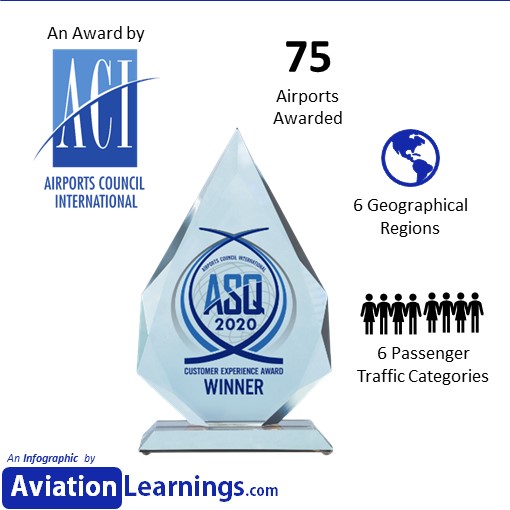
The year of award we are going to present is 2020 in which a total of 75 airports out of the 2,000 airports covered by Airports Council International were awarded the Airport Service Quality (ASQ) Award. The categories of awards were based on 6 geographical regions including:
- Africa
- Europe
- Asia-Pacific
- North America
- Middle East
- Latin America – Caribbean
Within these regions, awards were categorized based on annual passenger traffic categories of,
- Under 2 million
- 2 to 5 million
- 5 to 15 million
- 15 to 25 million
- 25 to 40 million
- Above 40 million
Out of the three main types of airport privatization, we have considered airports privatized through concession (or lease) agreements and through complete divesture of ownership as privately owned airports. It is so because majority control of the airport is transferred only in these two types of airport privatization.
How Airport Service Quality Award Works?
The basis of the award is the Airport Service Quality (ASQ) assessment carried out by Airports Council International (ACI) through standard surveys designed for passengers to offer their feedback regarding their perception of service quality of airport they used.
The survey comprises 33 quality attributes divided in eight broad quality categories related to different service areas of the airport including:
- Access to/from the airport
- Check-in services at the airport
- Airport’s passport control
- Airport Security
- Wayfinding within the airport
- Facilities for passengers within the airport
- Environment inside the airport
- Arrival services
Let us briefly look at each of these airport service quality areas to better understand the metric which is later going to be used for comparing state-owned (or public) airports with private airports.
Quality of Services in Airport Access
The first functional area which is evaluated in passenger surveys is Access at the airport. It includes 4 indicative items:
- How good are the Ground transportation to /from airport?
- How to visitors feel about the Availability of parking facilities?
- Whether or not parking facilities are good value for money or if the passengers feel that airport is overcharging.
- what do passengers feel about the availability of baggage carts/trolleys?
How Satisfied are Passengers with Check-ins?
The second functional area which is evaluated in passenger surveys is check-ins. It includes 3 indicative items:
- How much is the waiting time in check-in and how long are the queues?
- What about the Efficiency of check-in staff? And most importantly, what about the
- Courtesy and helpfulness of check-in staff?
How do International Passengers Feel About Passport Control?
The third functional area which is evaluated in passenger surveys is passport control which is focused on international passengers. It includes 2 indicative items:
- How much is the waiting time in passport clearance?
- What is the courtesy and helpfulness of passport staff?
What’s the Standard of Service in Airport Security?
The fourth functional area which is evaluated in passenger surveys is security. It includes 4 indicative items:
- How do passengers feel about the Courtesy and helpfulness of security staff? – an important item because security staff is generally disagreeable and security checking is one of the least enjoyable experiences at the airport.
- What about the thoroughness of security inspection? – because you don’t want security staff to become oriented towards customer experience. Their job is to keep you safe whether you dislike the way they do it.
- What about the waiting time at security inspection?
- Feeling of being safe and secure.
How Convenient is Wayfinding at the Airport?
The fifth functional area which is evaluated in passenger surveys is Wayfinding. It includes 4 indicative items.
- How easy is it for passengers to find their way through airport?
- What about the flight information screens?
- How much is the walking distance inside the terminal?
- And how easy is it for passengers to make connections with other flights?
How Good are Airport Facilities?
The sixth functional area which is evaluated in passenger surveys is an important one. It is about airport facilities. It includes 11 indicative items:
- How do passengers feel about the courtesy & helpfulness of airport staff?
- What about Restaurant/eating facilities?
- Are these restaurants good value for money?
- What about availability of bank /ATM facilities/money changers?
- How many shopping facilities are there at the airport?
- Are they good value for money?
- Does the airport have a good and free internet access/Wi-Fi?
- What about the availability and quality of Business/Executive lounges?
- What about the availability of washrooms/toilets?
- What about their cleanliness?
- What do passengers feel about the comfort of waiting/gate areas?
How Good is the Overall Airport Environment?
The second last functional area which is evaluated in passenger surveys is about airport environment. It includes 2 indicative items that are generally noticed as soon as you enter the airport. They are
- Cleanliness of airport terminal.
- Ambience of the airport.
What do Passengers Feel About Arrival Services?
The last functional area which is evaluated in passenger surveys is about arrival services. It has 3 indicative items:
- What do passengers feel about the Passport/Personal ID inspection when they reach the airport?
- What is the speed of baggage delivery service?
- What do passengers feel about customs inspection?
Now that we have explained how Airport Service Quality (ASQ) Award works, let us dive into comparing the two forms of airport ownership (public vs. Privately Owned) by seeing who has won more awards.
Public vs. Privately Owned Airports in Africa
If we look at the first geographical region i.e., Africa, Airport Service Quality (ASQ) award was given in three annual passenger traffic categories i.e., under 2 million, 2-5 million and 5-15 million.
Under 2 Million Annual Passenger Traffic Category
Moi International Airport in Mombasa Kenya won the ASQ award. The airport is owned by Kenya Airports Authority which is a state-owned organization.
2-5 Million Annual Passenger Traffic Category
Kotoka International Airport in Ghana won the ASQ award. The airport is owned by Ghana Airports Company Limited which is a state-owned company.
5-15 Million Annual Passenger Traffic Category
Two airports won the award:
- Jomo Kenyatta International Airport in Nairobi, Kenya. The airport is again owned by Kenya Airports Authority which is a state-owned organization.
- Nnamdi Azikiwe International Airport in Abuja, Nigeria. The airport is owned by Federal Airports Authority of Nigeria which is a again a state-owned organization.
Conclusively, in Africa, all of the airport service quality award winners are state-owned airports. However, a counter argument is that majority of the countries in Africa have airports under government ownership and private ownership is not as prevalent.
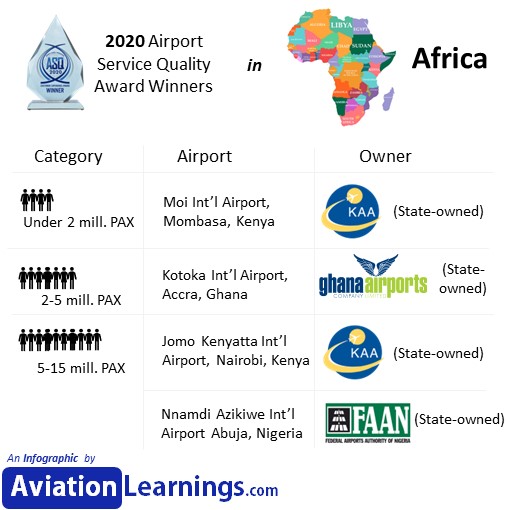
Public vs. Privately Owned Airports in Asia Pacific
We are now going to present the airport service quality award winner airports of Asia-Pacific Region in which a total of 28 airports won the airport service quality award.
Under 2 Million Annual Passenger Traffic Category
In the under 2 million passenger traffic category, three airports won the airport service quality award, all from Indonesia including Depati Amir Airport, Sultan Taha Airport and Silangit Airport. All three airports are under the ownership of Indonesian Airport Company Ang-Kasa Pura 2 which is a state-owned organization under Indonesian Ministry of State-Owned Enterprises.
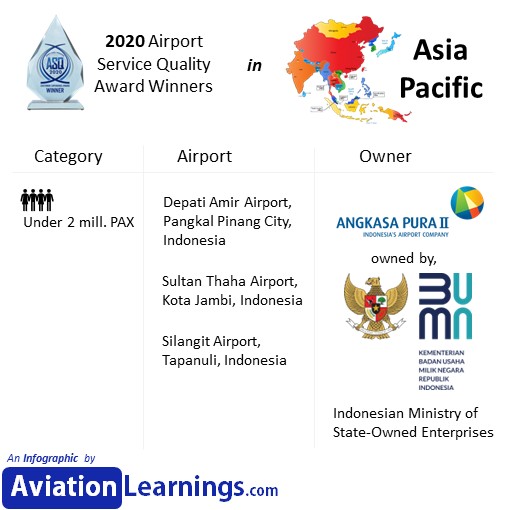
2-5 Million Annual Passenger Traffic Category
In the 2-5 million passenger traffic category, a total of seven airports won the airport. Among these were three Indian airports and four Indonesian airports.
The three airports of India included the Chandigarh Airport, Lal Bahadur Shastri int’l Airport and Sri Guru Ram Das Jee Int’l Airport. All three airports are under the ownership of Airports Authority of India (AAI), the Indian state-owned organization responsible for owning and operating Indian airports.
The four Indonesian airports included the Sultan Mahmud Badaruddin International Airport, Supadio Airport, Husein Sastranegara Airport and Jenderal Ahmad Yani International Airport. The first three airports are owned by the same Indonesian Airport Company we mentioned earlier i.e., Ang-Kasa Pura 2, while the Jenderal Ahmad Yani International Airport is owned by Angkasa Pura 1, which is also an Indonesian airports company. Both these companies are state-owned companies under Indonesian Ministry of State-Owned Enterprises.
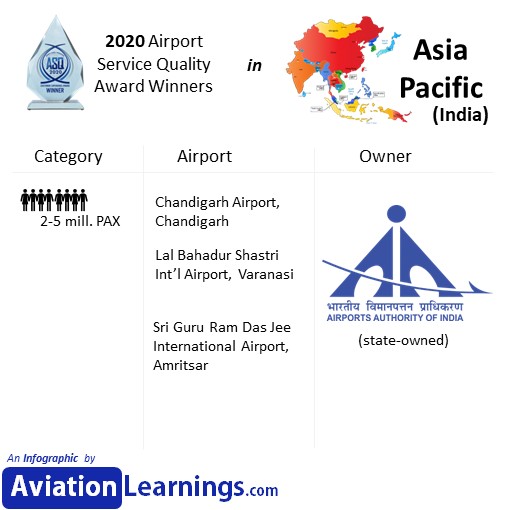
5-15 Million Annual Passenger Traffic Category
In the 5-15 million passenger traffic category, a total of six airports won the award. These included three airports from China whose ownership could not be exactly traced but presumably are under state-ownership. The remaining three airports included two airports from Indonesia and One airport from India.
Indonesian airports included Sultan Aji Muhammad International Airport and the Sultan Hasanuddin International Airport. While Cochin International Airport was the Indian airport to win the award. The first two are owned by the same state-owned Indonesian Airport Company we mentioned earlier i.e., Ang-Kasa Pura 1 while Cochin International airport is jointly owned by Cochin Int’l Airport Limited and Government of Kerala making it a mixed ownership or partnership airport.
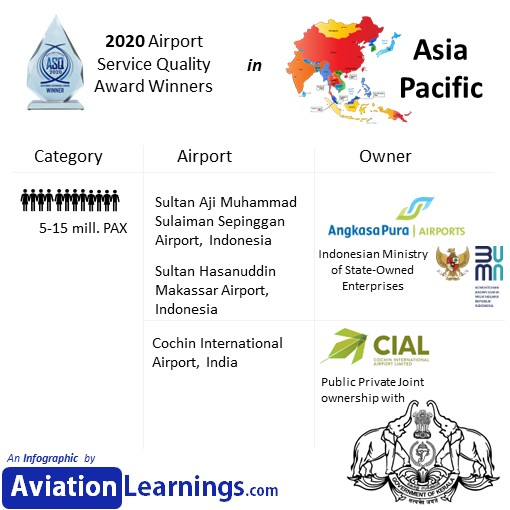
15-25 Million Annual Passenger Traffic Category
In the 15-25 million passenger traffic category, three airports won the airport service quality award. These included two airports from China whose ownership could not be exactly traced but presumably are under state-ownership. The remaining one airport was from India.
The Indian airport to win the award was the Rajiv Gandhi International Airport in Hyderabad, India. The airport is a joint venture company with majority ownership of GMR Group, a multinational Indian conglomerate, and minority ownerships of Airports Authority of India (AAI), Government of Telangana (state of India) and Malaysia Airports Holdings, a Malaysian state-owned company.
25-40 Million Annual Passenger Traffic Category
In the 25-40 million passenger traffic category in Asia-Pacific region, two airports won the airport service quality award. These included the Beijing Daxing International Airport in China and the Kempegowda International Airport in Bangalore, India.
The Beijing Daxing International Airport is owned by Beijing Capital Int’l Airport Co. Ltd. which is owned by a Chinese holding company called Capital Airport Holdings Ltd. The Capital Airport Holdings Ltd. in turn is owned by Civil Aviation Administration of China. It makes Beijing Daxing International Airport, a state-owned airport.
The Kempegowda International Airport in Bangalore, India is owned by Bangalore International Airport Ltd., a joint venture of private companies holding 74% stake and state-owned emprises holding 26% stake.
Private owners include Anchorage Infrastructure Investments Holdings Limited (43.64% stake); FIH Mauritius Investments Ltd. (10.36% stake) and Siemens Projects Ventures (20% stake). Government ownership comprises Karnataka State Industrial & Infrastructure Development Corporation Ltd. (13% stake) and Airports Authority of India (AAI) (13% stake).
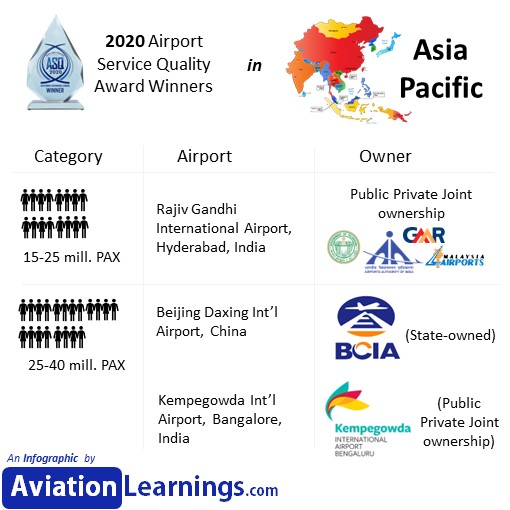
Over 40 Million Annual Passenger Traffic Category
In the busiest airports category i.e., over 40 million passenger traffic, seven airports from Asia-Pacific won the airport service quality award. These included four Chinese airports, two Indian airports and one Singaporean airport.
Chinese airports included the Beijing Capital International Airport; Guangzhou Baiyun International Airport; Shanghai Pudong International Airport and Shenzhen Bao’an International Airport.
Beijing Capital International Airport has similar ownership structure as Beijing’s other airport we discussed earlier i.e., Beijing Daxing International airport. It is state-owned airport.
Guangzhou International airport is privately owned while Shanghai Pudong Int’l airport is owned by Shanghai Airport Authority, a state-owned organization. The ownership of Shenzhen airport could not reliably traced but it presumably falls under state-ownership in China.
Two Indian airports who won the award in the same category included Chhatrapati Shivaji Maharaj International Airport and Indira Gandhi International Airport that are among the busiest airports of India.
Chhatrapati Shivaji Maharaj International Airport is a joint venture between the famous Indian billionaire Gautam Adani’s company and the state-owned Airports Authority of India (AAI).
Indira Gandhi International Airport is also a joint venture of multiple companies including the private Indian multinational conglomerate GMR Group; the German private airport operator company Fraport AG, and the state-owned Airports Authority of India (AAI).
Finally, the famous Singapore Changi Airport also won the award. It is owned by the Changi Airport Group that in turn is owned by Ministry of Finance, Singapore making it a state-owned airport.
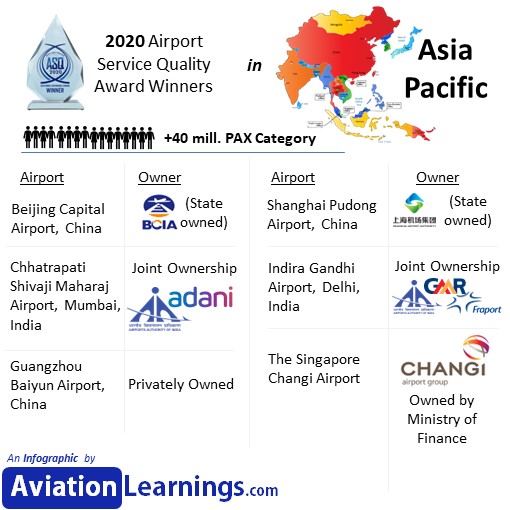
Concluding the overall picture of Asia-Pacific region, we find that:
- 16 airports with best service quality are state-owned airports from Indonesia, China, Singapore and India.
- 5 are mixed ownership airports, all from India.
- Only one is a private airport from China.
State-owned airports are predominantly providing better quality of airport services than privately owned airports. However, a counter argument can be that Asia-Pacific region does not have privatization as common as Europe and United Kingdom.
Public vs. Privately Owned Airports in Middle East
Two airports won the airport service quality award in the Middle Eastern region as discussed below.
5-15 Million Annual Passenger Traffic Category
In the 5-15 million passenger traffic category, only one airport from Middle East won the airport service quality award. It was the Queen Alia International Airport in Amman, Jordan. The airport is owned and operated by State of Jordan making it a state-owned airport.
15-25 Million Annual Passenger Traffic Category
In the 15-25 million passenger traffic category, the famous Abu Dhabi International airport won the airport service quality award. It is owned and operated by Abu Dhabi Airports Company Limited, which in turn is owned by Abu Dhabi Developmental Holding Company, which in turn is owned by the Government of Abu Dhabi. Therefore, the airport is a State-owned airport.
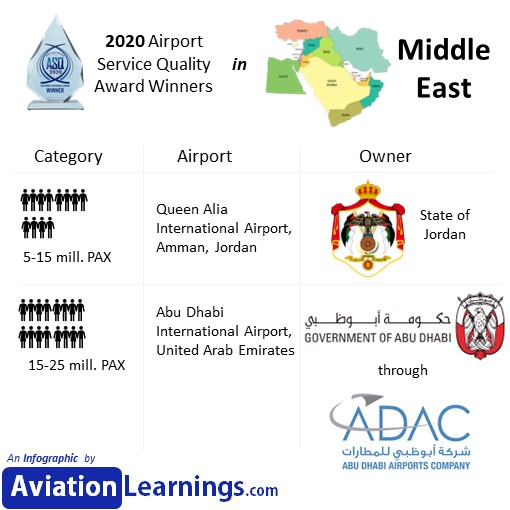
Public vs. Privately Owned Airports in North America
It is important to remember that United States has state-ownership as the prevalent form of airport ownership. Privatization is not trendy in the United States. Nonetheless, let us briefly present the best service quality providers in the North American region.
Under 2 Million Annual Passenger Traffic Category
In the under 2 million passenger traffic slab, Victoria International airport in Canada won the award. It is owned by the state-owned Victoria Airport Authority under Canadian government.
2-5 Million Annual Passenger Traffic Category
In the 2-5 million passenger traffic category, two airports from the United States won the award. They were Greenville Spartanburg international airport and Portland International jetport. As mentioned earlier regarding the prevalent form of airport ownership in United States being government ownership, the Greenville airport is owned by the Greenville-Spartanburg Airport District and the Portland jetport is owned and operated by the City of Portland i.e. the local government body.

5-15 Million Annual Passenger Traffic Category
In the 5-15 million passenger traffic slab, three American airports won the award. They included Indianapolis International Airport, John Glenn Columbus International Airport and San Antonio International Airport. All three airports are owned by their local governments and state-owned airport authorities.

15-25 Million Annual Passenger Traffic Category
In the 15-25 million passenger traffic category, two American airports again won the award. They included Austin-Bergstrom International Airport and the Dallas Love Field Airport. And just like last time, both the airport are owned and operated by the respective local governments.
25-40 Million Annual Passenger Traffic Category
In the 25-40 million passenger traffic category, two American airports again won the award. They included the Baltimore Airport and the Detroit Metropolitan Wayne County Airport. Both the airport are owned and operated by the respective local governments.

Over 40 Million Annual Passenger Traffic Category
And finally in the busiest airport with over 40 million passengers per year traffic, one American and one Canadian airport won the award. They included the world famous Hartsfield-Jackson Atlanta International Airport in the United States and the Toronto Pearson International Airport in Canada.
The former is owned by the City of Atlanta, as is usual for United States airports and the latter is owned by the state-owned Greater Toronto Airports Authority under Canadian government.
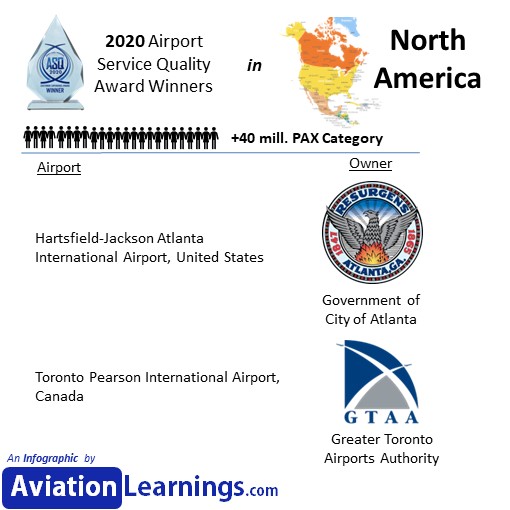
Conclusively, state-owned airports of North America have taken airport service quality awards in all passenger traffic categories which shows that big and small North American state-owned airports are delivering great quality of airport services.
Public vs. Privately Owned Airports in Europe
18 airports in Europe won the airport service quality award from Airports Council International (ACI) in 2020.
Under 2 Million Annual Passenger Traffic Category
In the under 2 million passenger traffic category, four European airports won the ASQ award. These included Granada Airport and Sebastian airport in Spain; Inverness Airport in United Kingdom, and Joao Paulo II Airport in Portugal.
Both of the Spanish airports are owned and operated by State-owned enterprise ENAIRE under Spanish Ministry of Public Works. Inverness airport is owned by Highlands and Islands Airports Ltd., a non-profit non-departmental public body owned by Scottish Ministers and falling under Transport Scotland, the Scottish ministry of transport. Lastly, Jaoao Paulo airport is owned and operated by ANA, the state-owned airport authority of Portugal.
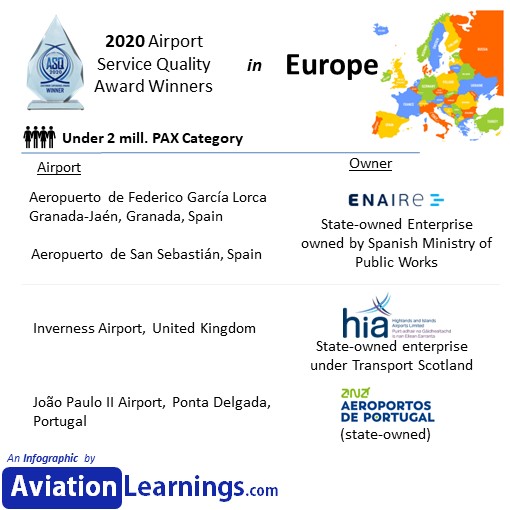
2-5 Million Annual Passenger Traffic Category
In the 2-5 million passenger traffic category, four European airports won the ASQ award. These included the Krasnoyarsk International Airport in Russia; Skopje International Airport in North Macedonia; Tallinn Airport in Estonia and Zagreb Airport in Croatia.
Among these, the Russian airport is owned by a Private company. The Macedonian airport is under private ownership of TAV Airports, a Turkish multinational company that stands among the world’s largest airport management companies. Talinn airport is owned by Tallinn Airport Ltd., a state-owned enterprise under Ministry of Economic Affairs and Communications, Estonia. Lastly, Zagreb airport is owned by a joint venture of private firms.
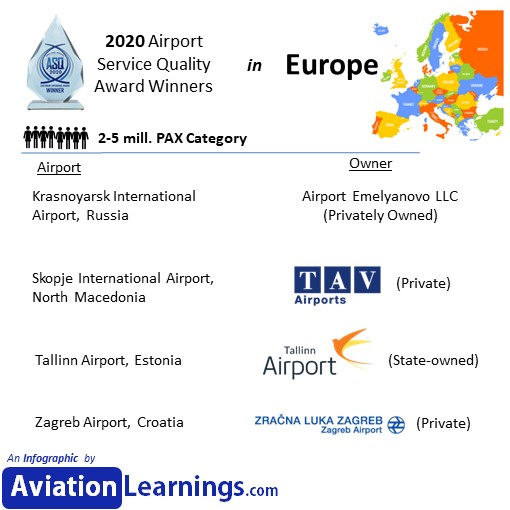
5-15 Million Annual Passenger Traffic Category
In the 5-15 million passenger traffic category, eight European airports won the ASQ award. These included:
- The Belgrade Nikola Tesla Airport in Serbia that is owned by Republic of Serbia but Operated by private company VINCI Airports;
- John Paul II International Airport in Poland that is owned by Majority owned by State Owned Enterprise Porty Lotnicze and minority shares held by provincial and municipality governments;
- Keflavik International Airport in Iceland that is owned by Isavia Ltd., the national state-owned airport and air navigation service provider of Iceland;
- London City Airport owned by a Consortium of private firms;
- Malta International Airport owned under partnership of Private Company Malta Mediterranean Link Consortium Limited (with 40% stake) and Government of Malta (with 20% stake);
- Sochi International Airport in Russia owned by Private company Basic Elements Ltd; and
- Two Portuguese airports namely Faro Airport and Porto Airport, both under private control of VINCI Airports we discussed earlier.

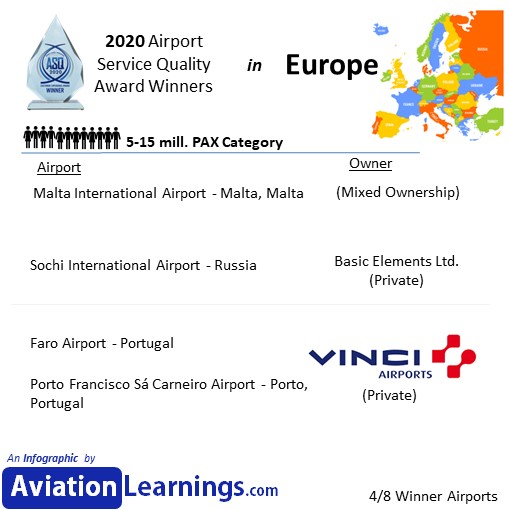
15-25 Million Annual Passenger Traffic Category
In the 15-25 million passenger traffic category, three European airports won the ASQ award. These included:
- The Helsinki-Vantaa Airport in Finland owned by Finavia., a public limited company owned by the State of Finland;
- Prague Airport in Czech Republic owned by Ministry of Finance, Czech Republic; and
- Pulkovo Airport in St. Petersburg, Russia owned by a private consortium Northern Capital Gateway LLC.

25-40 Million Annual Passenger Traffic Category
In the 25-40 million passenger traffic category, three European airports won the ASQ award. These included some famous airports that you may even have visited including
- Lisbon Airport in Portugal controlled by ANA – the Airports Authority of Portugal;
- Moscow Domodedovo Airport in Russia privately owned by Russian businessman Dmitry Kamenshchik through DME Ltd; and
- Zurich Airport in Switzerland owned by Flughafen Zürich AG.

Over 40 Million Annual Passenger Traffic Category
In the busiest European airports having traffic of over 40 million passengers per year, two airports won the airport service quality award. These included Aeroporto di Roma in Italy owned by the private company Atlantia S.p.A and Sheremetyevo International Airport in Moscow, Russia having mixed ownership with Sheremetyevo Holding Ltd. having majority shareholding and Russian State having minority shareholding.

Conclusively, if we look at the comparison of state-owned and privately owned airports in Europe, 12 privately owned airports have won service quality awards against 10 state-owned airports and one mixed ownership airport.
Europe was the most level playing field in comparing state-owned and privately owned airports because privatization of airports is common in Europe. However, as we saw, state-owned airports have competed against private airports in winning airport service quality award.
Public vs. Privately Owned Airports in Latin America
In Latin American region, five airports won the airport service quality award.
Under 2 Million Annual Passenger Traffic Category
In the under 2 million passenger traffic category, two airports won the ASQ award. These included the Curaçao International Airport in Netherlands Antilles owned by Curaçao Airport Holding which in turn is owned by State of Netherlands making it a state-owned (or public) airport. The second winner was Daniel International Airport in Liberia, Costa Rica owned by the State of Costa Rica.
2-5 Million Annual Passenger Traffic Category
In the 2-5 million passenger traffic category, only one Latin American airport won the ASQ award. It was the Olmedo airport in Ecuador. It is controlled by Private company TAGSA.

5-15 Million Annual Passenger Traffic Category
In the 5-15 million passenger traffic category, two Latin American airports won the ASQ award. These included the Punta Cana International Airport in Dominican Republic controlled by private company Grupo Puntacana and the Quito International Airport in Ecuador owned by state-owned corporation CORPAC.
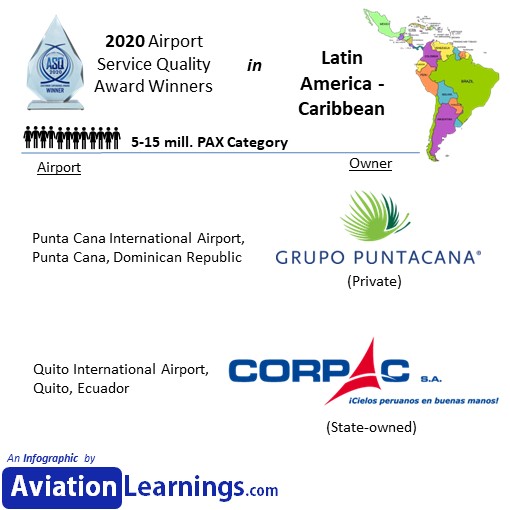
Conclusively if we look at the comparison of state-owned vs. private ownership in Latin America, three state-owned owned airports have won service quality awards against two privately owned airports.
Summary of Findings
Let us summarize our findings of the 2020 Airport Service Quality (ASQ) Award winners from Airports Council International (ACI) based on their ownership (public vs. privately owned):
- Africa
- 4 Airports won the award. All were state-owned (or public) airports.
- Asia-Pacific
- 16 state-owned airports won the award.
- One privately owned airport won the award.
- 5 joint/mixed ownership airports won the award.
- Middle East
- Two airports won the award. Both are state-owned (or public) airports.
- North America
- 12 airports won the award. All were state-owned (or public) airports.
- Europe
- 10 state-owned (or public) airports won the award.
- 12 privately owned airports won the award.
- One joint/mixed ownership airport won the award.
- Latin America – Caribbean
- 3 state-owned (or public) airports won the award.
- Two privately owned airports won the award.
Out of all the airports who won the 2020 Service Quality (ASQ) Award from Airports Council International (ACI), 47 airports were state-owned, 15 airports were privately owned and 7 airports had mixed ownership.
Six Chinese airports were left out from the comparison because their ownership could not be reliably traced. However, they presumably have state-ownership (being the prevalent form of airport ownership in China).
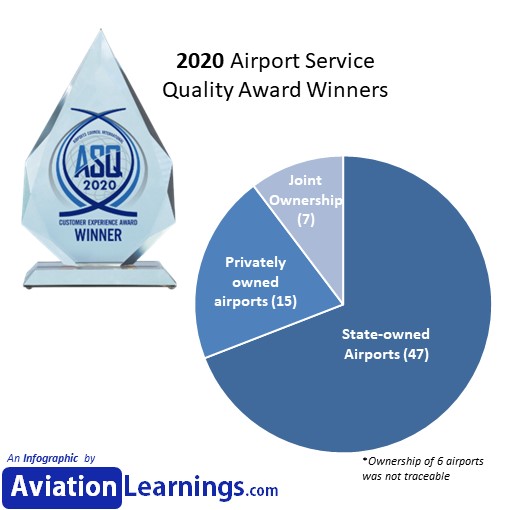
The Verdict
State-owned airports around the world have won more Airport Service Quality (ASQ) Awards from Airports Council International (ACI) than privately owned as well as joint ownership airports.
However, the above findings don’t necessarily mean that state-owned (or public) airports are always better than privately owned airports. More public airports winning the award must be seen with the fact that most airports are publicly owned around the world. Therefore, one group has a larger population size thereby making its success more likely.
However, the fact that becomes absolutely clear from our findings is that no stigma can be attached with public ownership of airports as an inherently inferior form of ownership. In simple words, the ideological bias towards private ownership of airports is unjustified. One cannot say that an airport should be privatized because private ownership of airport is inherently superior to public ownership due to any universal reason.
The above conclusion is further strengthened by noting that no specific trend in any one type of airport ownership coming out more successful than the other was observed in Europe – the most level playing field in the world in comparing state-owned and privately owned airports because privatization of airports is common in Europe.
If there is a single liner takeaway from this article it is that Privatization of state-owned airports may not be viewed as a guarantee for improvement in quality of airport services.
If you liked this article, share it with at least one person of common interest. It allows our work to be of service to people who can benefit from it the most.
You may also find this 3-hour online Airport Privatization Course interesting that explains all about airport privatization from its background and history and compares private airports with government-owned airports to develop good understanding of whether airport privatization is good or bad.